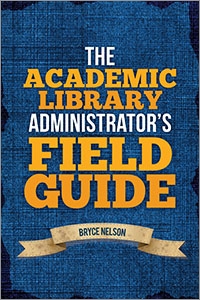Primary tabs
You don't need to be an ALA Member to purchase from the ALA Store, but you'll be asked to create an online account/profile during the checkout to proceed. This Web Account is for both Members and non-Members.
If you are Tax-Exempt, please verify that your account is currently set up as exempt before placing your order, as our new fulfillment center will need current documentation. Learn how to verify here.
- Description
- Table of Contents
- About the author
- Reviews
The daily administration of an academic library often leaves you needing quick advice on the topic at hand. Nelson, an experienced administrator writing from first-hand knowledge, delivers such advice in 30 topical chapters. Each chapter begins with an "Assertion," a one-sentence summary allowing you to rapidly scan the book and find what you need. When you're on the job you can dip into this guide for ready-to-use guidance on the full range of administrator responsibilities, such as
- How to think and act politically
- Preparing staff for safety and security procedures
- Influencing student and faculty's perception of the library as a basic component of education
- Fostering librarians' professional identity as teachers
- Communicating effectively, from email messages to meetings
- Assessment and systematic collection of data
Commentary sections in each chapter offer observations and interpretation, with abundant examples of useful advice. If you want to dig further into a topic, a Readings section points you to resources. Packed with insight about the day-to-day operations of the academic library, Nelson's guide will be invaluable to new and experienced administrators alike.
Contents
Acknowledgments
Introduction
Part I: Being Politically Effective
Chapter 1: Rationale: Mission, Goals, and Strategic Plan
Chapter 2: Perceptions: Library Components Are Basic to Education
Chapter 3: Political Influence: Roles of an Effective Leader
Chapter 4: Organizational Chart: The Academic Side, with Dotted Lines
Chapter 5: Context: Monitoring and Interpreting Trends
Chapter 6: Academic Ceiling: Dependencies and Levels of Quality
Chapter 7: Faculty: Gatekeepers of Library Usage
Chapter 8: Unexpected Events: Planning for Safety and Security
Part II: Managing and Leading Staff
Chapter 9: Beginning: Starting a New Position
Chapter 10: The Job: Nature of Administrative Work
Chapter 11: New Hires: Administrators’ Roles and Accountability
Chapter 12: Priorities: Aligning Work with Library Needs
Chapter 13: Professional Development: Investing In All Staff
Chapter 14: Accountability: Monitoring and Evaluating Work
Chapter 15: Decision-Making: Processes for Library Governance
Chapter 16: Communication: Internal and External Messages
Chapter 17: The Tone: Desirable and Productive Workplace
Chapter 18: How Are You? Issues of Health and Well-Being
Chapter 19: Change: Recognizing Need and Leading Change
Chapter 20: Errors in Judgment: Understanding and Learning
Chapter 21: Ending: Making a Transition
Part III: Supervising Operations
Chapter 22: Budget: Spending It All
Chapter 23: Librarians Who Teach: Professional Identity As Educators
Chapter 24: Building: Designed for Teaching, Learning, and Technology
Chapter 25: Collections: Meeting High Expectations for Content
Chapter 26: Website and Social Media: Designed for Maximum Use
Chapter 27: Technology: As Good As Anywhere on Campus
Chapter 28: Open Access to Information: Evidence of High Value
Chapter 29: Intellectual Property: Define, Educate, and Model
Chapter 30: Assessment: Describe, Understand, and Use
Index
Bryce Nelson, Ph.D.
Bryce Nelson, Ph.D., was University Librarian at Seattle Pacific University, and director of the libraries for the Seattle Public Schools. He is affiliate faculty at the University of Washington's Information School, and Seattle Pacific University's School of Education. He holds degrees from Northwestern University and the University of Washington.
"Although meant for academic administrators, the topics covered would be useful for all library administrators, especially the section on staff relationships—first impressions, accountability, professional development, establishing priorities, and communication ... Lucky are the librarians who work with a supervisor who applies even one third of the recommendations provided here."
— VOYA
"Readers falling between the student and administrator stages will find several chapters of interest - not least for beginning to understand what an administrator does."
— Australian Library Journal



